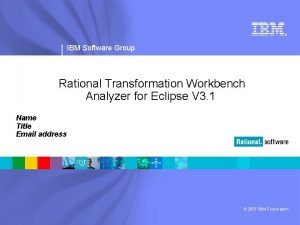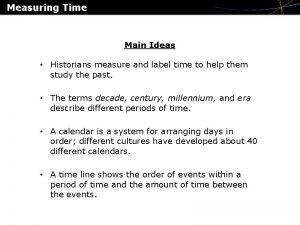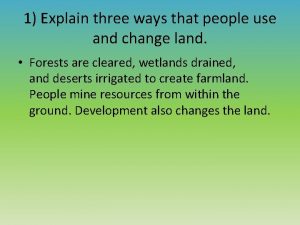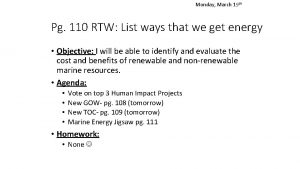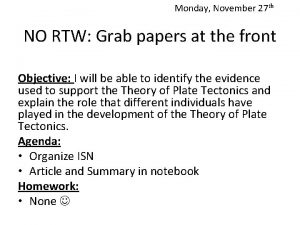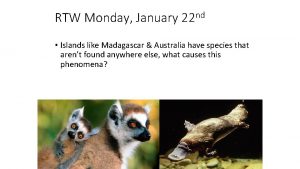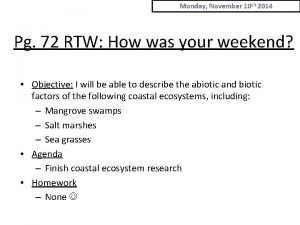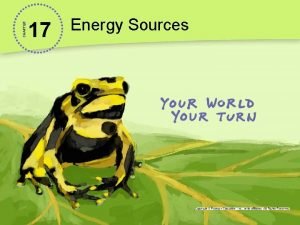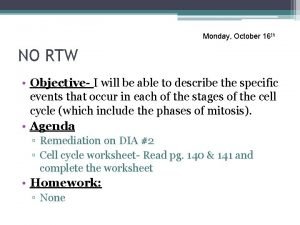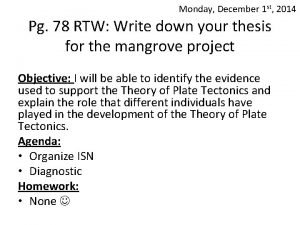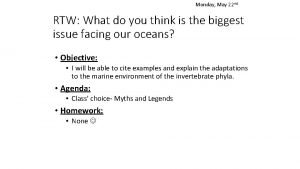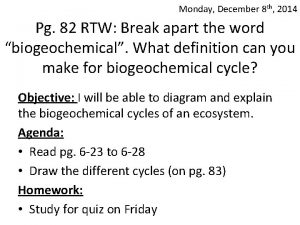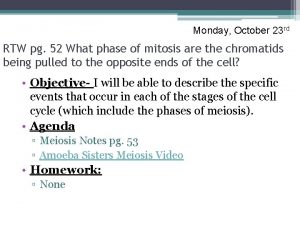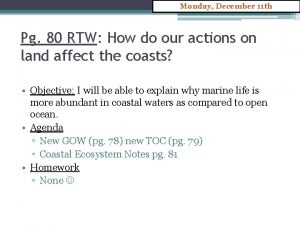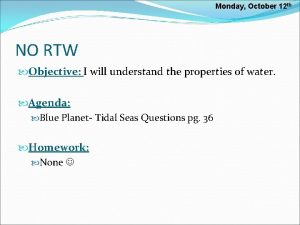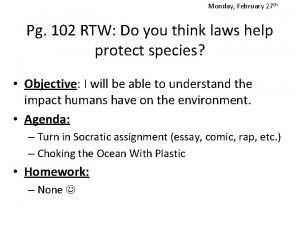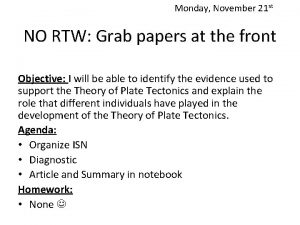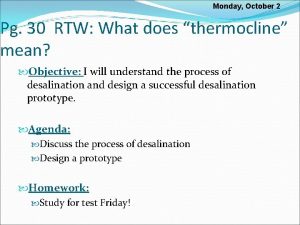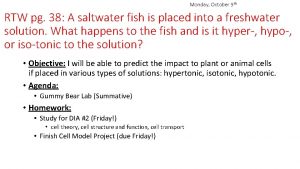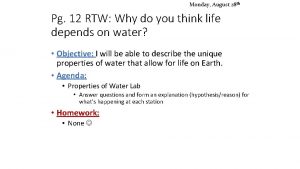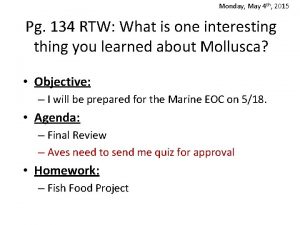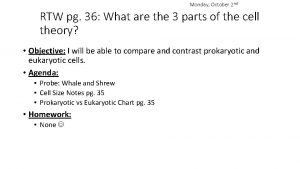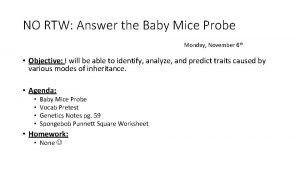Monday April 2 nd RTW List the ways












































- Slides: 44

Monday, April 2 nd RTW: List the ways that humans get energy to power our society • Objective: I will be able to describe the impact to an ecosystem’s loss of biodiversity. • Agenda: • Global Warming & Energy Notes • Turn in Work • • • Food Web Worksheet (from Friday) Carrying Capacity Worksheet (from Monday) Vocab Ch. 14 (from Monday) Yellowstone- Climate Change Questions (Wednesday) Moth Activity (Thursday) • Homework: • Finish Worksheets

Keeling Curve • Shows seasonal variations of carbon dioxide levels • Shows an increasing concentration of carbon dioxide

Energy Sources and Uses • Energy Sources • Renewable: Nearly always available or replaceable in a relatively short time • sunlight, wind, flowing water, biofuels • Nonrenewable: Cannot be replaced in a reasonable time • fossil fuels and nuclear energy Wind power is a renewable energy source.

Lesson 17. 1 Energy: An Overview Question! What type of energy source(s) does the United States use?

Answer!

Fossil Fuels • Include coal, oil, and natural gas • Formed from the remains of organisms over millions of years A front loader piles coal at a steam station in Dunkirk, New York.

Disadvantages of using Fossil Fuels: • Climate Change: Burning fossil fuels releases carbon dioxide • Air Pollution: When coal and oil burn, sulfur dioxide and nitrogen oxides are released, which contribute to smog and acid rain. • Water Pollution: Oil spills, equipment ruptures, and oil in runoff pollute waterways, oceans, and coastal areas. • Combustion: Coal-fired power plants release mercury, which harms human health. Did You Know? Coal-burning power plants cause 40% of mercury emissions due to human activity in the United States.

Natural Gas • Primarily methane gas with small amounts of other gases mixed in • Much less polluting than coal or oil and releases more energy when combusted what is fracking? http: //www. youtube. com/watch? v=d. Ze 1 Ae. H 0 Qz 8

Coal • Compared to other fossil fuels, coal is cheap, needs little processing, and is abundant. • Provides 1/4 of the world’s energy Did You Know? Coal is the most abundant fossil fuel on Earth. How Coal Forms

Coal Mining Strip mining: Overlying rock and soil are removed to access coal (safer for miners). Subsurface mining: Underground shafts are dug to access coal under Earth’s surface.

Gulf of Mexico Oil Well Explosions • 1979: Ixtoc I exploratory oil well • 50 m below surface • Released 126 million gal oil; containment efforts took 9 months • What didn’t work: cap, siphoning, controlled burn, “top kill” • What did work: relief wells • 2010: Deepwater Horizon oil well • 1500 m below surface • Largest U. S. offshore oil breach as of 2010— 21. 2 – 33. 5 million gal oil released during first 6 weeks, based on USGS rough estimates • Hundreds of miles of coastal habitats threatened • Methods tried: dome, cap, siphoning, controlled burns, “top kill, ” “junk shot, ” and relief wells Controlled burns attempt to contain oil pumping into the Gulf, one month after the 2010 well blow-out.

Damage Caused by Extracting Fuels • Mining: • Humans risk lives and respiratory health. • Ecosystems are damaged by habitat destruction, acid drainage, and heavy metal contamination downslope of mines. • Oil and gas extraction: • Roads and structures built to support drilling break up habitats and harm ecosystems. • The longterm consequences of accidents can be uncertain or unpredictable Acid drainage from a coal mine

Acid Drainage • Occurs when sulfide minerals in exposed rock surfaces react with oxygen and rain to produce acid.

Nuclear Fission • Splits an atomic nucleus into two smaller nuclei • Releases neutrons and large amounts of energy. If enough unstable nuclei are present, a nuclear chain reaction can occur. Did You Know? About 20% of electricity produced in the United States comes from nuclear power.

Generating Electricity Using Nuclear Energy How a nuclear reactor works

Benefits and Costs of Nuclear Power Benefits Costs No air pollution Expensive to build and maintain Requires little uranium fuel and little mining Catastrophic accidents are possible. MELTDOWN Nuclear waste must be stored for thousands of years. Under normal conditions, nuclear power plants are safer for workers than coal-burning power plants. Chernobyl

Nuclear Waste • Waste is currently held at power plants as a stopgap, but a long-term storage location is needed. • Long-term storage sites must be distant from population centers, protected from sabotage, have a deep water table, and be geologically stable. • Yucca Mountain, Nevada, was chosen by the U. S. government in the 1980 s, and a storage site was constructed there. But, as of 2010, the Yucca Mountain project is no longer under development. Yucca Mountain storage site

Generating Electricity With Hydropower • Hydropower is generated by turbines turned by moving water. • Two basic approaches: • Water flows through a dam and pushes turbines. • Naturally flowing water is diverted through turbines. • Naturally flowing water can lead to a variable supply of electricity. Dams provide constant electricity but can disturb natural habitats.

Benefits and Costs of Hydropower • Benefits: • Completely renewable • No air pollution or greenhouse gas emissions • Yields relatively cheap electricity • Costs: • Dams alter ecosystems and affect organisms (especially fish). • Dams trap soil-enriching silt, preventing it from reaching downstream. • Building dams and reservoirs can displace people.

Harnessing Solar Energy to Make Electricity • Photovoltaic cells (solar panels): Convert solar energy directly into electricity • Concentrating solar power: Uses mirrors to focus the sun’s rays on a vessel containing fluid; creates steam to push turbines and generate electricity. Solar Panel

Benefits and Costs of Solar Power • Benefits: • Inexhaustible • Clean—no air or water pollution produced during operation • Low maintenance devices • New jobs to make solar devices • Costs: • Some pollution during manufacture • Many regions aren’t sunny enough. • Devices are expensive.

Using Wind to Make Electricity • Wind turbines (windmills) convert wind’s kinetic energy to electrical energy. • Wind turbines can be placed on land or offshore. • Turbines can be solitary or built in groups called wind farms. Did You Know? Average wind speeds are 20% faster offshore than on land.

Benefits and Costs of Wind Power • Benefits: • No pollution or greenhouse gases produced during operation • Under good wind conditions, produces far more energy than it uses • Relatively cheap to operate • Costs: • High startup costs • Winds can be unpredictable. • Fastest winds are often not near population centers. • Communities complain about the looks and noise of wind farms. • Can be harmful to birds and bats

Tuesday, April 3 rd No RTW • Objective: I will be able to describe the impact to an ecosystem’s loss of biodiversity. • Agenda: • Predator Prey Worksheet • Turn in Work • • • Food Web Worksheet (from Friday) Carrying Capacity Worksheet (from Monday) Vocab Ch. 14 (from Monday) Yellowstone- Climate Change Questions (Wednesday) Moth Activity (Thursday) • Homework: • Finish Worksheets

Wednesday, April 4 th RTW: What do you think is the best type of energy source? • Objective: I will be able to describe the impact to an ecosystem’s loss of biodiversity. • Agenda: • Carbon Cycle Game • Turn in Work • • • Food Web Worksheet (from Friday) Carrying Capacity Worksheet (from Monday) Vocab Ch. 14 (from Monday) Yellowstone- Climate Change Questions (Wednesday) Moth Activity (Thursday) • Homework: • Finish Worksheets

Copy on a sheet of paper Station Stop 1. 2. 3. 4. 5. 6. 7. 8. 9. 10. What Happens Destination

At the bottom of your chart: With your data table, create a BAR GRAPH to represent how much time you spent in each location of the environment. Make sure you label ALL parts of your graph!

Exit Slip: Three Two One 3. What are three things you learned from the lab? a. b. c. 2. Write two questions that you have about this topic. a. b. 1. Write down one thing you liked about the lab.

Thursday, April 5 th RTW: Describe one way that carbon moves through the environment (absorbed/released)? • Objective: I will be able to describe the impact to an ecosystem’s loss of biodiversity. • Agenda: • Biogeochemical Cycle Notes • Turn in Work • • • Food Web Worksheet (from Friday) Carrying Capacity Worksheet (from Monday) Vocab Ch. 14 (from Monday) Yellowstone- Climate Change Questions (Wednesday) Moth Activity (Thursday) • Homework: • Finish Worksheets

Some Questions from Yesterday: • Why does carbon get stuck? • Percentage of carbon in the ocean and soil? • How does carbon escape plants/atmosphere? • What’s the deep ocean? • Where does carbon come from? • Why is there so much carbon in the atmosphere? • Why does carbon make the ocean more acidic? • Why is having too much carbon bad? • Can you live without carbon? • What is the relationship?

KEY CONCEPT Matter cycles in and out of an ecosystem.

Water cycles through the environment. • The hydrologic, or water, cycle is the circular pathway of water on Earth. • Organisms all have bodies made mostly of water. precipitation condensation transpiration lake surface runoff evaporation water storage in ocean groundwater see pag e

Elements essential for life also cycle through ecosystems. • A biogeochemical cycle is the movement of a particular chemical through the biological and geological parts of an ecosystem. • The main processes involved in the oxygen cycle are photosynthesis and respiration.

• Oxygen cycles indirectly through an ecosystem by the cycling of other nutrients. oxygen photosynthesis respiration carbon dioxide

• Carbon is the building block of life. – The carbon cycle moves carbon from the atmosphere, through the food web, and returns to the atmosphere. – Carbon is emitted by the burning of fossil fuels. – Some carbon is stored for long periods of time in areas called carbon sinks. carbon dioxide in air combustion respiration photosynthesis respiration decomposition of organisms fossil fuels photosynthesis carbon dioxide dissolved in water

• The nitrogen cycle mostly takes place underground. – Some bacteria convert gaseous nitrogen into ammonia through a process called nitrogen fixation. – Some nitrogen-fixing bacteria live in nodules on the nitrogen in atmosphere roots of plants; animals others live freely in the soil. plant nitrogen-fixing bacteria in decomposers roots ammonification nitrogen-fixing ammonium bacteria in soil nitrifying bacteria nitrates nitrifying bacteria nitrites denitrifying bacteria

• Ammonia released into the soil is transformed into ammonium. – Nitrifying bacteria change the ammonium into nitrate. – Nitrogen moves through the food web and returns nitrogen in atmosphere to the soil during animals decomposition. plant nitrogen-fixing bacteria in decomposers roots ammonification nitrogen-fixing ammonium bacteria in soil nitrifying bacteria nitrates nitrifying bacteria nitrites denitrifying bacteria

• The phosphorus cycle takes place at and below ground level. – Phosphate is released by the weathering of rocks. – Phosphorus moves through the food web and returns to the soil during decomposition. rain geologic uplifting – Phosphorus leaches into groundwater weathering of phosphate from rocks from the soil and runoff plants is locked in sediments. animalsphosphate in solution in soil – Both mining and leaching agriculture add sedimentation phosphorus into decomposers forms new rocks the environment.

Friday, April 6 th RTW: How does the cycling of inorganic molecules affect us? • Objective: I will be able to describe the impact to an ecosystem’s loss of biodiversity. • Agenda: • Aquatic Ecosystems • Turn in Work • • • Food Web Worksheet (from Friday) Carrying Capacity Worksheet (from Monday) Vocab Ch. 14 (from Monday) Yellowstone- Climate Change Questions (Wednesday) Moth Activity (Thursday) • Homework: • Finish Worksheets

ABIOTIC FACTORS FOR AN AQUATIC ECOSYSTEM • DEPTH • LATITUDE • TEMPERATURE • PROXIMITY TO LAND • SALINITY • UNDERWATER TOPOGRAPHY (ROCKS & CAVES) • LIGHT • PH • OXYGEN • CARBON DIOXIDE • NITROGEN • PHOSPHOROUS

Depth • Pressure increases • Dissolved oxygen levels decrease • Temperature (generally) decreases

Temperature Some organisms can only handle a set range of temperatures

Light • Affects organisms if they are photosynthetic or eat the photosynthetic producers • Light only reaches 200 m below the ocean surface

Salinity • Some animals can adapt to salinity changes (like the bull shark) • Others are strictly fresh or salt water
 Ibm rtw
Ibm rtw Gods ways are not our ways
Gods ways are not our ways List the ways historians label time
List the ways historians label time Explain the three ways
Explain the three ways Quá trình desamine hóa có thể tạo ra
Quá trình desamine hóa có thể tạo ra Sự nuôi và dạy con của hươu
Sự nuôi và dạy con của hươu Thế nào là mạng điện lắp đặt kiểu nổi
Thế nào là mạng điện lắp đặt kiểu nổi Các châu lục và đại dương trên thế giới
Các châu lục và đại dương trên thế giới Các loại đột biến cấu trúc nhiễm sắc thể
Các loại đột biến cấu trúc nhiễm sắc thể Bổ thể
Bổ thể Thế nào là sự mỏi cơ
Thế nào là sự mỏi cơ Phản ứng thế ankan
Phản ứng thế ankan Thiếu nhi thế giới liên hoan
Thiếu nhi thế giới liên hoan Fecboak
Fecboak Bài hát chúa yêu trần thế alleluia
Bài hát chúa yêu trần thế alleluia điện thế nghỉ
điện thế nghỉ Một số thể thơ truyền thống
Một số thể thơ truyền thống Trời xanh đây là của chúng ta thể thơ
Trời xanh đây là của chúng ta thể thơ Hệ hô hấp
Hệ hô hấp Công thức tính thế năng
Công thức tính thế năng Thế nào là số nguyên tố
Thế nào là số nguyên tố Tỉ lệ cơ thể trẻ em
Tỉ lệ cơ thể trẻ em đặc điểm cơ thể của người tối cổ
đặc điểm cơ thể của người tối cổ Các châu lục và đại dương trên thế giới
Các châu lục và đại dương trên thế giới ưu thế lai là gì
ưu thế lai là gì Môn thể thao bắt đầu bằng chữ đua
Môn thể thao bắt đầu bằng chữ đua Tư thế ngồi viết
Tư thế ngồi viết Bàn tay mà dây bẩn
Bàn tay mà dây bẩn Hình ảnh bộ gõ cơ thể búng tay
Hình ảnh bộ gõ cơ thể búng tay Cách giải mật thư tọa độ
Cách giải mật thư tọa độ Từ ngữ thể hiện lòng nhân hậu
Từ ngữ thể hiện lòng nhân hậu Tư thế ngồi viết
Tư thế ngồi viết Ví dụ giọng cùng tên
Ví dụ giọng cùng tên Gấu đi như thế nào
Gấu đi như thế nào Thẻ vin
Thẻ vin Thơ thất ngôn tứ tuyệt đường luật
Thơ thất ngôn tứ tuyệt đường luật Hổ sinh sản vào mùa nào
Hổ sinh sản vào mùa nào Thế nào là hệ số cao nhất
Thế nào là hệ số cao nhất Diễn thế sinh thái là
Diễn thế sinh thái là Vẽ hình chiếu vuông góc của vật thể sau
Vẽ hình chiếu vuông góc của vật thể sau Lp html
Lp html Làm thế nào để 102-1=99
Làm thế nào để 102-1=99 Lời thề hippocrates
Lời thề hippocrates Vẽ hình chiếu đứng bằng cạnh của vật thể
Vẽ hình chiếu đứng bằng cạnh của vật thể Tư thế worm breton là gì
Tư thế worm breton là gì
